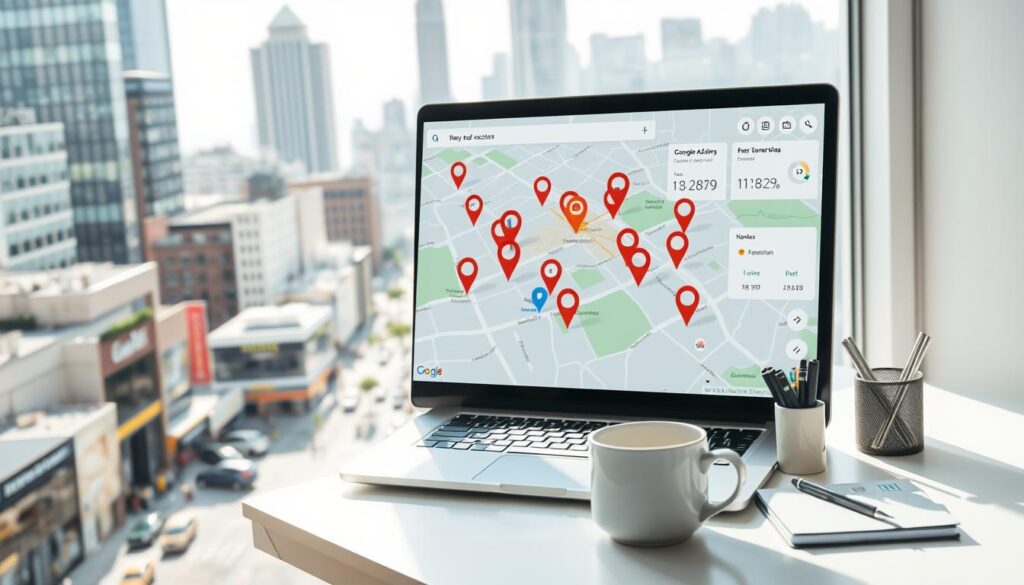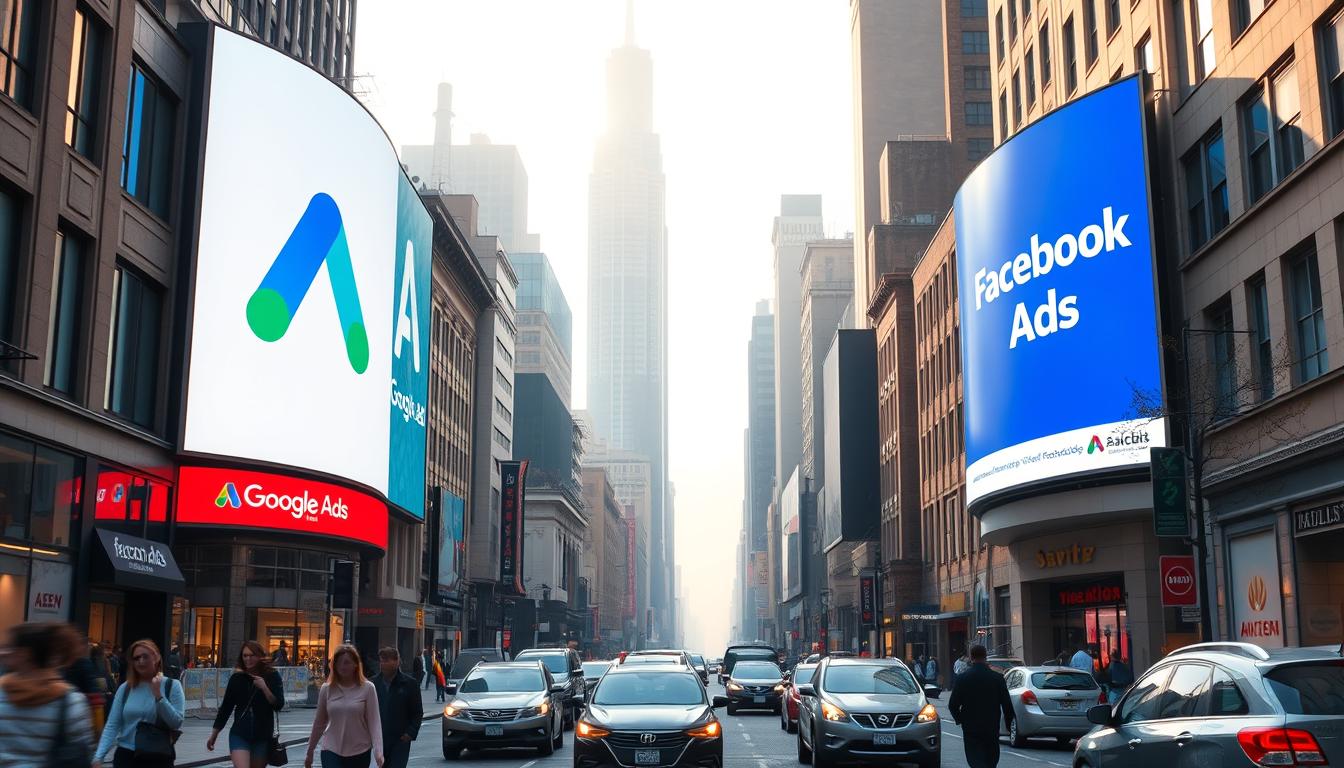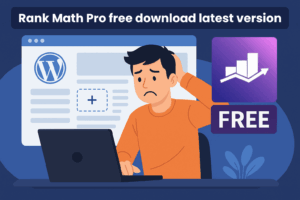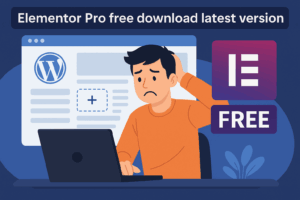Choosing the right advertising platform is crucial for local businesses aiming to reach their target audience effectively. In the digital landscape, Google Ads and Facebook Ads are two dominant players, each offering unique benefits and drawbacks.
For local businesses, understanding the pros and cons of each platform is essential to maximize their online marketing efforts. While Google Ads excels in targeting users with specific search intent, Facebook Ads offers advanced demographic targeting capabilities.
This comparison will help local businesses make informed decisions about their online advertising strategies, ensuring they allocate their budget effectively.
Table of Contents
ToggleKey Takeaways
- Understanding the strengths and weaknesses of Google Ads and Facebook Ads is crucial for local businesses.
- Google Ads excels in search intent targeting, while Facebook Ads offers demographic targeting.
- Local businesses must consider their target audience and marketing goals when choosing an advertising platform.
- Effective online marketing strategies can significantly impact a local business’s success.
- Budget allocation should be based on the chosen platform’s ROI potential.
The Digital Advertising Landscape for Local Businesses
The digital advertising landscape for local businesses is rapidly evolving, with new opportunities emerging to connect with local customers. As technology advances and consumer behavior shifts, local businesses must adapt their advertising strategies to remain competitive.
The Importance of Online Advertising for Local Reach
Online advertising is crucial for local businesses as it allows them to reach their target audience more effectively. With most consumers turning to the internet to find local services and products, a strong online presence is essential. Targeted advertising enables local businesses to reach potential customers who are actively searching for their services, increasing the likelihood of conversion.
Key Metrics Local Businesses Should Track
To measure the effectiveness of their advertising efforts, local businesses should track key metrics such as click-through rates (CTR), conversion rates, and return on ad spend (ROAS). Monitoring these metrics helps businesses understand their ad performance and make data-driven decisions to optimize their campaigns.
| Metric | Description | Importance |
|---|---|---|
| CTR | Measures the percentage of users who click on an ad after viewing it. | Indicates ad relevance and appeal. |
| Conversion Rate | Tracks the percentage of users who complete a desired action. | Reflects the effectiveness of the ad in driving desired outcomes. |
| ROAS | Calculates the revenue generated by an ad campaign relative to its cost. | Helps determine the profitability of an ad campaign. |
Google Ads vs Facebook Ads for Local Businesses: Platform Overview
In the realm of local business advertising, Google Ads and Facebook Ads offer distinct advantages. Understanding the nuances of each platform is crucial for making an informed decision.
Platform Reach and User Intent Differences
Google Ads and Facebook Ads differ significantly in terms of platform reach and user intent. Google Ads primarily targets users who are actively searching for products or services, indicating a higher purchase intent. In contrast, Facebook Ads allow businesses to target users based on demographics, interests, and behaviors, often reaching potential customers before they are ready to make a purchase.
The reach of these platforms also varies. Google Ads are limited to users searching on Google and its partner sites, whereas Facebook Ads can reach users across Facebook, Instagram, and other affiliated platforms. This difference in reach and user intent can significantly impact the effectiveness of advertising campaigns for local businesses.
- Google Ads: Targets users with high purchase intent, limited to Google and partner sites.
- Facebook Ads: Targets based on demographics and interests, broader reach across multiple platforms.
Advertising Models and Basic Functionality
The advertising models of Google Ads and Facebook Ads also have distinct characteristics. Google Ads operates on a pay-per-click (PPC) model, where advertisers pay for each ad click. Facebook Ads, on the other hand, offers a variety of pricing models, including cost per click (CPC), cost per thousand impressions (CPM), and cost per action (CPA).
Understanding these differences is key to selecting the most appropriate platform for local business advertising goals. By considering the unique strengths of each platform, businesses can create more effective advertising strategies.
Google Ads: Strengths for Local Businesses
Local businesses can significantly enhance their online visibility and customer acquisition through Google Ads. This platform offers a range of tools and features tailored to the specific needs of local businesses, helping them reach potential customers at the right moment.
Search Intent and Customer Acquisition Benefits
Google Ads excels at capturing search intent, allowing local businesses to target users who are actively searching for products or services they offer. This intent-driven marketing ensures that ads are shown to users with a high likelihood of conversion. By leveraging Google Ads, local businesses can drive relevant traffic to their websites and physical locations.
Local Service Ads and Map Pack Visibility
Google’s Local Service Ads (LSAs) provide a significant advantage for local businesses. LSAs appear at the top of search results, offering prominent visibility and trust badges that can enhance credibility. Additionally, being featured in the Map Pack can drive local foot traffic, as it highlights businesses on Google Maps. This visibility is crucial for local customer acquisition.
Display Network and YouTube Integration
Beyond search ads, Google Ads offers the Display Network and YouTube integration, allowing local businesses to expand their reach. The Display Network enables businesses to target relevant websites and audiences, while YouTube ads can help build brand awareness through video content. This multi-channel approach can be particularly effective for local businesses looking to diversify their marketing efforts.
| Feature | Benefit | Impact on Local Businesses |
|---|---|---|
| Search Intent Targeting | Reaches users actively searching for products/services | High conversion rates due to targeted advertising |
| Local Service Ads | Provides trust badges and prominent visibility | Enhanced credibility and visibility in search results |
| Display Network & YouTube | Expands reach through visual and video advertising | Diverse marketing opportunities for brand awareness |
Google Ads: Potential Drawbacks for Local Businesses
While Google Ads can be a powerful tool for local businesses, it’s not without its challenges. As with any advertising platform, there are potential drawbacks that businesses should be aware of to maximize their return on investment.
Cost Considerations and Competitive Keywords
One of the primary concerns for local businesses using Google Ads is the cost. Competitive keywords can drive up costs, making it challenging for smaller businesses to compete. For instance, keywords related to legal or medical services can be particularly expensive. To mitigate this, businesses can focus on long-tail keywords that are more specific and less competitive, potentially reducing costs.
| Keyword Type | Average Cost-Per-Click | Competition Level |
|---|---|---|
| Generic Keywords | $5-$10 | High |
| Long-Tail Keywords | $1-$5 | Low to Medium |
Learning Curve and Management Complexity
Google Ads can be complex to manage, especially for businesses without prior experience in paid advertising. The platform offers a wide range of features and targeting options, which can be overwhelming. To overcome this, businesses can invest in training or consider hiring a professional to manage their campaigns. Additionally, starting with simple campaigns and gradually increasing complexity can help in managing the learning curve.

Facebook Ads: Advantages for Local Businesses
For local businesses, Facebook Ads provides a unique combination of advanced targeting capabilities and visual marketing opportunities. This allows businesses to reach their target audience more effectively and build brand awareness in their local community.
Advanced Demographic and Interest-Based Targeting
Facebook Ads offers advanced demographic and interest-based targeting options, enabling local businesses to reach their ideal customer base. According to Facebook’s advertising data, businesses can target users based on age, location, interests, behaviors, and more. This level of targeting precision ensures that local businesses can effectively reach potential customers who are likely to be interested in their products or services.
As Mark Zuckerberg, CEO of Meta, once said, “The key to successful advertising is not just reaching a large audience, but reaching the right audience.” Facebook Ads enables local businesses to do just that, by providing the tools necessary to target their advertising efforts with precision.
Visual Marketing and Brand Awareness Benefits
Facebook Ads also offers significant visual marketing and brand awareness benefits for local businesses. With the ability to create engaging ads that include images, videos, and other multimedia elements, businesses can capture the attention of their target audience and build brand recognition.
A well-crafted Facebook Ad campaign can help local businesses establish a strong online presence, driving brand awareness and customer loyalty. By leveraging Facebook’s vast user base and advanced advertising capabilities, local businesses can effectively compete with larger competitors and establish themselves as leaders in their local market.
Instagram Integration and Multi-Platform Reach
Another significant advantage of Facebook Ads for local businesses is the integration with Instagram, allowing for multi-platform reach. By advertising on both Facebook and Instagram, local businesses can expand their reach and engage with their target audience across multiple platforms. This is particularly important, as many consumers use both Facebook and Instagram, and businesses can benefit from having a presence on both platforms.
By leveraging Facebook Ads and Instagram integration, local businesses can create a comprehensive online advertising strategy that drives real results. As part of a broader social media marketing effort, Facebook Ads can help local businesses build a strong online presence and reach their target audience more effectively.
Facebook Ads: Limitations for Local Businesses
The effectiveness of Facebook Ads for local businesses is hindered by several key limitations. While the platform offers advanced targeting capabilities and visual marketing benefits, local businesses must consider these drawbacks when making digital marketing choices.
Lower Purchase Intent and Conversion Challenges
One significant limitation is the lower purchase intent on Facebook compared to search engines like Google. Users on Facebook are often browsing casually, making it challenging to achieve high conversion rates. This can be particularly problematic for local businesses relying on immediate sales or leads. To overcome this, local businesses must develop creative paid marketing strategies that capture users’ attention and drive conversions.
Algorithm Changes and Declining Organic Reach
Another challenge local businesses face on Facebook is the impact of algorithm changes on organic reach. As Facebook’s algorithms evolve, businesses often see a decline in their organic visibility, making it necessary to rely more heavily on paid advertising. This can increase the overall cost of marketing on the platform and make it less appealing for businesses with limited budgets. An effective advertising comparison between Facebook and other platforms like Google Ads can help businesses decide where to allocate their marketing resources.
Budget Considerations: Cost Comparison and ROI Analysis
Understanding the cost implications of Google Ads and Facebook Ads is crucial for local businesses aiming to maximize their ROI. Allocating a marketing budget effectively between these two platforms requires a deep dive into their respective cost structures and potential returns.
Average Cost-Per-Click and Cost-Per-Acquisition Metrics
The cost of advertising on Google Ads and Facebook Ads can vary significantly based on several factors, including industry, location, and targeting options. Google Ads operates on a pay-per-click (PPC) model, where advertisers pay each time a user clicks on their ad. The average cost-per-click (CPC) for Google Ads can range from $1 to $2 across all industries, but it can be much higher for competitive keywords.
Facebook Ads, on the other hand, allows for more flexible pricing models, including cost-per-click (CPC), cost-per-thousand-impressions (CPM), and cost-per-conversion. The average CPC for Facebook Ads is generally lower than Google Ads, often cited around $0.97 across all industries.
| Platform | Average CPC | Average CPA |
|---|---|---|
| Google Ads | $1-$2 | $48.96 (varies widely by industry) |
| Facebook Ads | $0.97 | $11.12 (e-commerce), varies by industry |
Setting Realistic Budgets for Each Platform
When setting a budget for Google Ads or Facebook Ads, local businesses must consider their overall marketing goals, target audience, and the competitive landscape. For Google Ads, a daily budget of $5-$10 can be a good starting point, allowing for sufficient data collection without overspending.
For Facebook Ads, starting with a smaller daily budget (e.g., $5) can help in testing different ad creatives and targeting options. It’s essential to monitor ad performance closely and adjust budgets accordingly to optimize ROI.
Targeting Capabilities: Reaching Your Local Audience
Targeting capabilities play a pivotal role in determining the success of local businesses’ advertising strategies on Google Ads and Facebook Ads. Effective targeting ensures that local businesses can reach their intended audience, increasing the likelihood of conversion.
Both platforms offer unique targeting options that cater to different aspects of local business advertising. Understanding these capabilities is crucial for developing a successful advertising strategy.
Google's Location and Keyword Targeting
Google Ads excels in location targeting, allowing local businesses to reach customers based on their geographic location. This includes targeting by country, region, city, or even a specific radius around a business location. “Google Ads’ location targeting is highly effective for local businesses as it ensures that ads are shown to users who are more likely to visit the physical location,” says an expert in local SEO. Google’s keyword targeting further enhances this by allowing businesses to target specific search queries, ensuring their ads appear in front of users actively searching for their products or services.

Additionally, Google Ads offers advanced features like location bid adjustments, allowing businesses to increase or decrease their bids based on the performance of specific locations. This level of granularity helps in optimizing ad spend for better ROI.
Facebook's Demographic and Behavioral Targeting
Facebook Ads, on the other hand, offers robust demographic and behavioral targeting options. Local businesses can target users based on age, gender, interests, behaviors, and more. This allows for a highly personalized advertising approach, where ads are tailored to resonate with the target audience.
Facebook’s targeting capabilities also extend to custom audiences, lookalike audiences, and detailed targeting options that combine various characteristics to pinpoint the ideal customer. As noted by a social media advertising expert, “Facebook’s ability to target users based on their interests and behaviors makes it an invaluable platform for local businesses looking to build brand awareness and engage with their community.”
By leveraging these targeting capabilities, local businesses can create highly effective advertising campaigns on both Google Ads and Facebook Ads, ensuring they reach and engage with their local audience effectively.
Campaign Types and Ad Formats for Local Success
The key to a successful local advertising campaign lies in understanding the various ad formats and campaign types available on Google Ads and Facebook Ads. Local businesses must navigate these options to maximize their reach and conversion rates.
Effective Google Ad Formats for Local Businesses
Google Ads offers several ad formats that can be highly effective for local businesses. Search Ads are particularly useful for capturing local intent, allowing businesses to target users actively searching for their products or services.
Search Ads for Local Intent
These ads are triggered by specific keywords and appear at the top of search engine results, providing immediate visibility to potential customers.
Local Service Ads
Local Service Ads are another powerful tool, allowing businesses to promote their services directly in search results, complete with a “Google Guaranteed” badge that can enhance credibility.
Display and Video Ads
Additionally, Display and Video Ads on YouTube and across the Google Display Network can help local businesses build brand awareness and reach a wider audience.
High-Performing Facebook Ad Types for Local Reach
Facebook Ads also offers a range of ad formats that can be highly effective for local businesses. Location-Based News Feed Ads allow businesses to target users based on their geographic location, increasing the ad’s relevance.
Location-Based News Feed Ads
These ads appear directly in users’ news feeds, making them more engaging and likely to be noticed.
Local Awareness Ads
Local Awareness Ads are designed to drive foot traffic to local businesses by targeting users who are in or near the business’s location.
Carousel and Collection Ads
Furthermore, Carousel and Collection Ads provide visually engaging ways to showcase products or services, allowing users to interact with the ad content directly.
By leveraging these campaign types and ad formats, local businesses can create effective digital marketing strategies that drive results.
Implementation Strategies: Setting Up Your First Campaign
Launching a successful ad campaign on Google Ads or Facebook Ads requires careful planning and execution, especially for local businesses. To effectively reach their target audience, local businesses must consider several key factors when setting up their first campaign.
Google Ads Setup Essentials for Local Businesses
To maximize the effectiveness of a Google Ads campaign, local businesses should focus on several key areas:
Keyword Research for Local Intent
Conduct thorough keyword research to identify terms with local intent, such as service areas or geographic keywords. For example, a plumber in New York might target keywords like “NYC plumber” or “emergency plumbing services New York.”
Location Targeting Settings
Ensure that location targeting is set correctly to reach the desired geographic area. Google Ads allows targeting by country, region, city, or even a specific radius around a business location.
Ad Copy Best Practices
Craft ad copy that resonates with the local audience by highlighting local services, offers, or unique selling points. Including the business’s location in the ad copy can also improve relevance.
| Google Ads Feature | Description | Benefit for Local Businesses |
|---|---|---|
| Keyword Research | Identifying relevant local keywords | Increases ad visibility for local searches |
| Location Targeting | Targeting specific geographic areas | Ensures ads are shown to the intended local audience |
| Ad Copy Optimization | Crafting ad copy with local relevance | Improves ad engagement and conversion rates |
Facebook Ads Setup Best Practices
For Facebook Ads, local businesses should consider the following best practices:
Audience Definition for Local Markets
Define the target audience based on demographics, interests, and behaviors that align with the local business’s customer profile.
Creative Elements That Drive Engagement
Use high-quality, relevant visuals and compelling ad copy that resonates with the local audience, driving engagement and conversions.
Call-to-Action Optimization
Optimize the call-to-action (CTA) to encourage the desired response from the target audience, such as “Get Directions” or “Call Now.”
Industry-Specific Considerations for Local Advertising
Industry-specific considerations play a crucial role in determining the success of local advertising campaigns. Different sectors have unique challenges and opportunities that require tailored advertising strategies. Understanding these industry-specific needs is essential for local businesses to effectively reach and engage their target audience.
Retail and E-commerce Local Businesses
Retail and e-commerce local businesses benefit significantly from targeted advertising that highlights their products and promotions. Google Ads can be particularly effective for capturing search intent, while Facebook Ads offer robust targeting options based on demographics and interests. For instance, a local boutique can use Facebook’s targeted ads to reach young adults with specific fashion interests.
Service-Based Local Businesses
Service-based businesses, such as law firms, medical practices, and home repair services, often require a different approach. These businesses benefit from advertising that emphasizes their expertise and builds trust. Google Ads can help service-based businesses appear in search results for relevant queries, while Facebook Ads can be used to share customer testimonials and service promotions.
Restaurants and Hospitality
Restaurants and hospitality businesses thrive on visual appeal and local reputation. Instagram-friendly ads on Facebook can showcase their ambiance, cuisine, and services. Google Ads can target users searching for dining or accommodation options in their area, making it an effective platform for driving reservations and bookings.
| Industry | Google Ads Strategy | Facebook Ads Strategy |
|---|---|---|
| Retail & E-commerce | Targeted search ads for products | Demographic and interest-based targeting |
| Service-Based | Search ads emphasizing expertise | Testimonials and service promotions |
| Restaurants & Hospitality | Targeted search ads for dining/accommodation | Visual ads showcasing ambiance and services |
Using Both Platforms: Integrated Strategies
To maximize online visibility, local businesses can benefit from integrating both Google Ads and Facebook Ads into their marketing strategy. This approach allows businesses to capitalize on the strengths of each platform, creating a more comprehensive online advertising effort.
Complementary Campaign Approaches
By using Google Ads and Facebook Ads together, local businesses can implement complementary campaign approaches that enhance their overall marketing effectiveness. Google Ads excels at capturing high-intent search traffic, while Facebook Ads offers advanced targeting capabilities based on demographics and interests. A combined strategy allows businesses to both drive immediate conversions and build brand awareness.
For instance, a local business could use Google Ads to target users actively searching for their products or services, while simultaneously running Facebook Ads to reach a broader audience and nurture potential customers through the sales funnel.
Budget Allocation Between Platforms
When allocating budget between Google Ads and Facebook Ads, local businesses should consider their specific marketing objectives and the ROI potential of each platform. A balanced approach often yields the best results, as it allows businesses to diversify their online advertising efforts and mitigate risks associated with relying on a single platform.
| Platform | Primary Strength | Recommended Budget Allocation |
|---|---|---|
| Google Ads | High-intent search traffic | 60% |
| Facebook Ads | Advanced demographic targeting | 40% |
Ultimately, the optimal budget allocation will depend on the business’s specific goals, target audience, and the performance data collected over time. Regular analysis and adjustment of the budget allocation are crucial to maximizing ROI.
Real-World Success Stories: Local Business Case Studies
The effectiveness of Google Ads and Facebook Ads for local businesses is evident in numerous success stories. These platforms have become essential tools for businesses looking to expand their local reach and customer base.
Local businesses have achieved significant results by leveraging the strengths of these advertising channels. By understanding the unique benefits of each platform, businesses can create targeted campaigns that drive real results.
Google Ads Local Business Success Examples
Google Ads has proven to be a powerful tool for local businesses, particularly those with high-intent search campaigns. For instance, a local plumbing service saw a 50% increase in service calls after implementing targeted Google Ads. Another example is a local boutique that experienced a 30% boost in in-store traffic using Google’s Local Service Ads.
These success stories highlight the potential of Google Ads for local businesses, especially when combined with effective keyword targeting and ad copy.
Facebook Ads Local Business Success Examples
Facebook Ads has also delivered impressive results for local businesses, particularly in terms of brand awareness and customer engagement. A local restaurant chain increased its followers by 200% through targeted Facebook Ads, while a local gym saw a 25% increase in membership sign-ups using Facebook’s lead generation ads.
These examples demonstrate the effectiveness of Facebook Ads in reaching and engaging local audiences, driving both online and offline conversions.
Measuring Success: Analytics and Tracking
Measuring the success of online advertising strategies is crucial for local businesses to optimize their marketing efforts. To achieve this, businesses must leverage analytics and tracking tools to assess the performance of their campaigns.
Google Analytics and Google Ads Integration is a powerful combination for local businesses. By linking these two platforms, businesses can track the effectiveness of their Google Ads campaigns and understand how they drive website traffic and conversions. This integration enables businesses to make data-driven decisions and optimize their advertising strategies.
Google Analytics and Google Ads Integration
With Google Analytics and Google Ads integration, local businesses can gain insights into their campaign performance, including metrics such as click-through rates, conversion rates, and return on ad spend. This information helps businesses identify areas for improvement and optimize their campaigns for better results.
Facebook Pixel and Conversion Tracking
Facebook Pixel is another essential tool for local businesses. It allows businesses to track conversions, optimize ads, and build targeted audiences. By implementing Facebook Pixel, businesses can measure the effectiveness of their Facebook Ads campaigns and make informed decisions to improve their online presence management.
Conclusion: Making the Right Choice for Your Local Business
Choosing between Google Ads and Facebook Ads for local businesses depends on understanding the unique strengths of each platform and aligning them with your business goals. Google Ads excels in capturing search intent, making it ideal for businesses seeking immediate conversions. Facebook Ads, on the other hand, offers advanced demographic targeting and visual marketing capabilities, enhancing brand awareness and reach.
When deciding on a local advertising comparison between Google Ads and Facebook Ads, consider your target audience’s behavior and your business objectives. For local businesses focusing on driving foot traffic or immediate sales, Google Ads might be the more effective choice. Conversely, for businesses aiming to build brand awareness or target specific demographics, Facebook Ads could be more suitable.
Ultimately, a successful online marketing strategy for local businesses may involve leveraging both platforms. By understanding the strengths and limitations of Google Ads and Facebook Ads, local businesses can create a balanced advertising approach that maximizes their online visibility and drives growth.
FAQ
What are the key differences between Google Ads and Facebook Ads for local businesses?
Google Ads and Facebook Ads differ in their targeting capabilities, ad formats, and user intent. Google Ads are ideal for capturing search intent, while Facebook Ads excel at demographic and interest-based targeting.
How do I choose between Google Ads and Facebook Ads for my local business?
The choice between Google Ads and Facebook Ads depends on your business goals, target audience, and marketing objectives. Consider factors like search intent, demographic targeting, and ad formats to decide which platform is best for your local business.
What are the benefits of using Google Ads for local businesses?
Google Ads offers several benefits for local businesses, including the ability to capture search intent, Local Service Ads, and Map Pack visibility. It also provides Display Network and YouTube integration, allowing for broader reach and engagement.
What are the limitations of Facebook Ads for local businesses?
Facebook Ads have limitations for local businesses, including lower purchase intent and conversion challenges. Additionally, algorithm changes and declining organic reach can impact the effectiveness of Facebook Ads.
How can I measure the success of my local advertising campaigns on Google Ads and Facebook Ads?
To measure success, use Google Analytics and Google Ads integration for Google Ads, and Facebook Pixel and conversion tracking for Facebook Ads. These tools help track key metrics, such as conversions, click-through rates, and return on ad spend.
Can I use both Google Ads and Facebook Ads for my local business?
Yes, using both Google Ads and Facebook Ads can be an effective integrated marketing strategy. By leveraging the strengths of each platform, you can create complementary campaigns that drive results for your local business.
How do I allocate my budget between Google Ads and Facebook Ads?
Budget allocation depends on your business goals, target audience, and marketing objectives. Consider factors like cost-per-click, cost-per-acquisition, and return on ad spend to determine the optimal budget allocation for each platform.
What are the best ad formats for local businesses on Google Ads and Facebook Ads?
Effective ad formats for local businesses include Search Ads, Local Service Ads, and Display Ads on Google Ads, and Location-Based News Feed Ads, Local Awareness Ads, and Carousel Ads on Facebook Ads.
How can I optimize my Google Ads and Facebook Ads campaigns for better ROI?
To optimize campaigns, focus on keyword research, location targeting, and ad copy best practices for Google Ads, and audience definition, creative elements, and call-to-action optimization for Facebook Ads.










